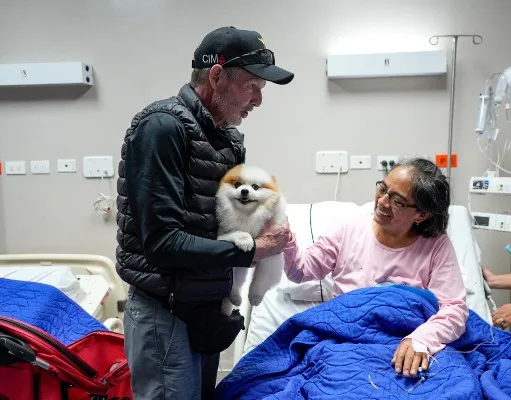One of Cuenca’s best kept secrets, the Siervas de Maria (Servants of Mary) hospice nuns, provide the support of a loving family
Wendy Jane Carrel
On December 2, 1826, a baby girl was born on Calle de la Flor Baja in the neighborhood of San Martin, Madrid, Spain and named Bibiana Antonia Manuela Torres Acosta. As the story is told, above her bed was a painting of the Virgin Mary, to whom she prayed every day as a child.

Sor Marina, Sor Magdalena, and Madre Teresa.
Short of stature, but with a big heart, she was a reflective child dedicated to reading. She was also fascinated by nuns. At the age of 25 she learned of Don Miguel Martinez, a priest who wanted to help the ill, and joined his mission as a nun. The year was 1851. Soon after, Don Miguel was called to the island of Fernando Po off the coast of Cameroon.
By this time Manuela’s name had changed to Maria Soledad (Maria for the Virgin Mary and Soledad, to be alone or in solitude), not to be confused with Maria de la Soledad, Our Lady of Solitude. And thus, in 1855, the Fundacion de las Siervas de Maria (Servants of Mary) began, a foundation that would send nurse nuns to the bedsides of the ill around the world.
There are currently 115 houses of Siervas de Maria in 22 countries: two in Cameroon (the only presence in Africa), four in Italy, four in Cuba, six in Bolivia, six in the U.S., seven in Mexico, and 54 in Spain. The mother house is in Rome, Italy. There are three houses in Ecuador: Cuenca, Guayaquil, and Quito. (See http://www.sisterservantsofmary.org/ for more country details).
There are 1,628 Servants of Mary. Of the 115 houses, 96 send nurses to private homes, three house chronically ill patients within their convents, one is dedicated to both home and hospital care. There are six Servants of Mary clinics, as well as centers for AIDS patients.

Sister Aurora and Madre Teresa.
In Cuenca, eight nuns provide in-home hospice care from 8 p.m. to 5 a.m. daily. Families of the ill pick them up at the convent at 7:30 p.m. six days a week.
This is not a somber order. The nuns, dressed in pure white, are warm and friendly. They have an innate ability to connect and extend themselves to others. My experience after a year of visits, is that they provide the feeling of a loving family. They light up when I or anyone else appears. I have confidence in them and feel safe in their presence as do hundreds of families throughout Cuenca. They are here to serve, angels on earth ministering to the ill. I have nicknamed them the “love bugs of Cuenca” for their quiet, gentle manners, their receptiveness, their openheartedness, their enigmatic smiles, and their celestial light. It is comfortable to be in their presence.
The Cuenca Siervas de Maria have served the city for 57 years. Their daily work is performed with uncommon faith. They seem to intuit the needs of patients, they understand the value of silence. They primarily sit hospice, and are present for the most sacred transition of all, end-of-life in this realm. They serve not only in homes but also in Cuenca hospitals and clinics. They are welcome and seen as a relief for most hospital staffs. The Siervas are not permitted, however, to sit hospice at SOLCA (the cancer hospital) or at FASEC (a hospice home next to SOLCA).

Siervas de Maria Convent, Cuenca.
Their motto is, “all I can do is serve.” They believe in the grace of God, that God provides, and in divine will. They do not attempt to control or intervene, they accompany and support. They serve anyone of any belief, and of any background, rich or poor.
When asked about their activities at the bedside of the ill Madre Teresa S. S M Chanagà responded, “our work is to serve our brothers (humanity) with everything they need – administering medication, bathing, changing their positions during the night, offering healings, physical therapy, companionship with conversation, and the spiritual part – bringing an encounter with God our Father, discovering the meaning and value of suffering through Christ our savior.”
Siervas de Maria nuns from Latin America usually receive a combination of nursing and pastoral training in Colombia or Spain. Many attend international Siervas de Maria continuing care conferences in the Dominican Republic, Italy, Panama, and Spain. Madre Teresa of the Cuenca house, for example, received additional training from Spain’s most well-known palliative care physician and professor, Dr. Marcos Gomez Sancho. She is conversant in both allopathic and naturopathic therapies. Most Siervas de Maria serve about three to five years in one convent and are then transferred to another city or country. The mother house decides who is sent where and when. Six of the current Cuenca Siervas are from Colombia, one is from Ecuador, and another from Mexico.
Financial survival of Siervas de Maria is based on donations which they do not solicit. They believe they will always be provided for, and they are, just as they have provided for others. In Spanish there is an expression offered when someone has done something wonderful for you, “Dios le pague,” God will repay you. Families of the ill are grateful; they repay the nuns.
The Cuenca Siervas de Maria church and convent is located on a quiet residential street not far from the Feria Libre on Calle Naranjos near Avenida de las Americas. The nuns speak Spanish only, one nun speaks a little Italian. If you are in need of their services, you would go in person to ask. Mass at their church is open to the public at 9 a.m. on Sundays.
Siervas de Maria founder Maria Soledad Torres Acosta was beatified by the Catholic church in 1950, and canonized in 1970. She is now remembered as a saint.
Wendy Jane Carrel, M.A., is a Spanish speaking North American. She has spent over two years traveling province to province in Ecuador (as well as in Chile and Mexico) researching senior care options. In her home state of California she served as a Senior Center Director for a city, Head of Information and Outreach for a County Office on Aging, Administrator in Assisted Living (including Alzheimer’s care), and as a non-profit communications and grants officer. She offers guidance for North Americans who wish assistance negotiating the Ecuadorian health system, senior care options countrywide, end-of-life care, and disposition of remains. See www.WellnessShepherd.com or contact her at wellnesshepherd@aol.com
















